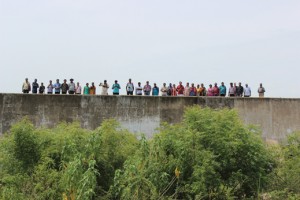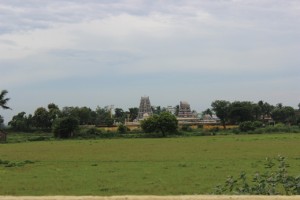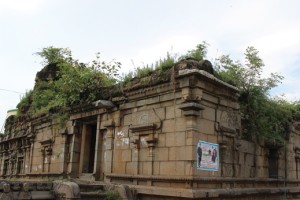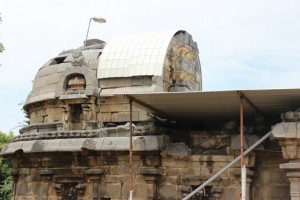Registered with the Registrar of Newspapers for India under R.N.I 53640/91
Vol. XXV No. 15, November 16-30, 2015
The temples of the Cooum
by Sudha Umashanker
In recent times, the Cooum has gone from being looked at and described as an eyesore, a garbage dump, an unholy mess, and other such unflattering epithets to being spoken with respect and reverence as a sacred river which, in years gone by, was a veritable lifeline that supported people who lived along its course.

Atop Kesavaram dam.
This dramatic shift in perception is largely due to the efforts of groups such as ‘The Cooum: A Cultural Mapping’ spearheaded by novelist Venkatesh Ramakrishnan, and blogger and founder of Aalayam Kanden Trust, Padmapriya Baskaran, who have been systematically uncovering newer facets of the river over the past few months.
Mythologically speaking, the Cooum originates in Koovam village in Tiruvallur District. Geographically the 72 km long Cooum is a branch of the River Kosathalaiyar, which itself is a break away from the Palar and splits into two near Kesavaram, about 72 km from Chennai, with the left branch continuing as the Kosathalaiyar and the right branch (southern branch) becoming the Cooum. The Cooum, which forks and straddles the Island Grounds, at Chennai at the tailend finally enters the Bay of Bengal.
While of the 72 km stretch, roughly a fourth criss-crosses the heart of Chennai, the rest flows past idyllic, lush green villages as yet untouched greatly by the trappings of city life and largely out of view for many city folk.
Recently ‘The Cooum: A Cultural Mapping’ team took a group of 33 people from different walks of life but with one common passion – a love for history and heritage – on an edutaining day-trip to visit some of the temples on the banks of the Cooum in and around the Thiruvirkolam village and see other landmarks.

Koovam Temple( Thirupurantakeswara temple) at Thiruvirkolam.
The logical place to begin at was the source, so, after stopping by the Tharkathamman temple – the village deity who is a guardian spirit in Thiruvirkolam aka Koovam in Thiruvalluvar District – we headed a short distance towards the Thirupurantakeswara Temple with a beautiful tank adjacent to it.
Says Padmapriya Baskaran, “Legend has it that during the Tripura Samhara when Lord Shiva who set out to decimate three asuras embarked on the mission without the customary first obeisance to Ganesha, the God of Beginnings, Shiva paid the price for it and the axle of his chariot came off. As Lord Shiva staggered, he rested his bow on the ground and water (old Palar) sprung up from the Vruddha Ksheera Nadhi to run as the Cooum and washed His feet. In that sense the Cooum is considered even holier than the Ganges.”
This large, well-laid-out temple with a Gajaprastavimana (a vimana shaped like the seated elephant) is just the kind of temple that would typically double as a social hub, where the people of the village would congregate. An outstanding feature of the main idol, the Lingam, is that it is untouched by the priests (theenda thirumeni) to this day and whose exterior changes colour to foretell the monsoon (white signifying good rains and red a failed monsoon).
Temple maintenance was taken care of by the kings, royals and devotees who donated in cash and kind and willed land or property or the income there from. As proof of this we saw a stone sculpture of Kazhugachala Swamigal who had willed property to the Koovam temple and others in the vicinity (Ilambayankottur temple). We also saw the names of a long list of patrons on a board at the temple (interestingly, many Mudaliars figured in this list).

Senji Janamejayeswara temple.
What is even more interesting is that there is evidence of Buddhist presence as well. A larger-than-life Buddha statue recovered from the fields in the area here was moved to the Chennai Museum’s Amaravati gallery. Incidentally, there are references made in literary works that speak of the Buddhist influence says Padmapriya Baskaran, “Gnanasambandar in his Thevaram speaks about the vast presence of Jains and Buddhists in the Koovam village. This was also reconfirmed through Mylai Seeni Venkadasamy’s book in Tamil titled Bouthamum Tamizhum.”
We also got to see an Azhikal – a stone used to mark the boundaries of a Vishnu temple just outside a smaller temple dedicated to Lord Kariyamanicka Perumal. Opinion was initially divided as to whether this was a Buddhist Dharma Chakra or not.
As many as 140 temples have been identified along the banks of the Cooum, right from the ones in Chennai. One of the earliest Pallava inscriptions in Tamil was found at Sitrambakkam, one of our stops, and dates to 679 CE, corroborating the earliest recorded evidence of a structural temple. Extracts from Epigraphia Indica Vol. 32 too reinforce this.
As the river has shrunk in recent times and its course altered somewhat, the temples are not right on the banks but a kilometre or so away from it. Some of them are in a better state thanks to coming under the State Archaeology Department but there are others which are in state of utter ruin and neglect.
One such is the Chola temple dedicated to Janamejayeswara at Senji which is crying for attention. The once beautiful granite structure today has a tree growing out of it and through it and is even plastered with a wall poster. There is rubble and stagnant water on one side, abandoned idols are strewn about and the main deity has been relocated as the roof is in imminent danger of crumbling. There is no priest at present and therefore no poojas and people, gripped by fear, desist from entering the ill-lit and crumbling sanctum.

Gajaprasta Vimana at Thirupurantakeswara temple.
Our next stop was the Sivapuram Rajarajeswaramudaiya Mahadevar Temple built by Rajaraja I and which predates the Big Temple at Thanjavur. What came as a shocker was the information that several priceless bronzes (Abhimana Meru Vidangal with Umadeviyar and Aadhavallan, which have been recorded in one of the over twenty inscriptions here relating to Rajendra I) are missing. Other inscriptions throw light on various kinds of patronage received. One of them refers to a channel leading to a lake from the river Cooum having been made tax-free and given to the temple. Another mentions gold ornaments and new bronze icons provided and yet another talks of a ritual conducted on Sundays, termed Aditya Vaara Perumbali, along with details of the staff and wages.
It is apparent that our forefathers have been meticulous and forthcoming in documenting relevant information,something unthinkable in the present times. Incidentally, at Koovam too, inscriptions speak about sale of land for developing a feeder canal to the Koovam tank and the lifting of fishing and paddy taxes to fund its repair.
Getting to Kesavaram from Sivapuram involved a short drive and a long walk. The Kesavaram Dam is a major landmark. Ironically there was not a drop of water in sight.
In 1942, the Kesavaram dam, aka Koovam dam, was built within 10 km of where the Kosathalaiyar splits into two, effectively sealing off the water from the Cooum. Venkatesh Ramakrishnan notes that the legislature that passed the order perhaps met in the University Senate House on the very banks of the Cooum and voted to kill the river! The dam was supposed to push the Cooum’s waters into the parent river and the Poondi Lake eventually. Rainwater that falls into the river after the dam is also huge in quantity and another check dam at Korattur diverts it to quench the city’s thirst.
As we stood on the dam itself, Venkatesh Ramakrishnan regaled us with stories of the struggle for power in the distant past.
“Three historic battle fields, Pullalur, Perambakkam and Thakkolam, lie in the triangle formed with the Kesavaram as the epicentre so to speak. The bitter power struggles saw the use of poison tipped arrows in earlier battles and steel rockets in later times. During the Chalukyan invasion of 618 CE Pulikesi and Mahendra Pallava battled it out for the control of the historic city of Kanchipuram. Three centuries later, the Cholas were beaten by the Confederacy of Western Gangas, Banas and Vaidumbas led by the Rashtrakuta king Krishna III in 949 CE and lost their crown prince Rajaditya (who died astride an elephant) which tragedy facilitated his brother’s ascension to the throne at Tanjore and catapulted Raja Raja from otherwise definite obscurity.
“During the Carnatic wars there was one battle at Perambakkam in which a wily Tipu Sultan in the middle of a stormy night attacked an unsuspecting British army bogged down by the floods in the twin rivers.”
After we walked over to the Kailaya Eswaramudaya Mahadevar Temple, also decrepit, historically built on the Moksha Dweepam Island formed by Cooum and Kosathalaiyar (but now safely resting on the north bank) we literally trudged back through wet, slushy fields, braving the ants and thorns to get to the nearest main road and to Edayarpakkam for the lunch break and a visit to the Thirupada Kadudaya Mahadevar temple of Kuluthunga I. But if any member of the group was asked if he/she would do the Cooum trip all over again, the answer would definitely be a resounding ‘yes’.

